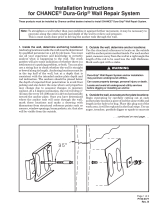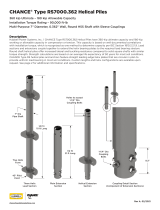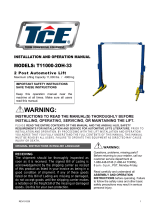Page is loading ...

INSTALLATION OF T1500080 WALL ANCHOR KIT
Working-Load Rating: 9,000 lb (40 kN)
Top View
Procedures to stabilize wall pushing:
T1500080, Rev B. 03/2021
chancefoundationsolutions.com
1. Placement of wall anchors should be determined by qualified personnel and shall be consistent with the anchors’
working-load rating. To straighten wall immediately, the wall may need to be excavated from the outside prior to
loading.
2. Drill 3" (76 mm) hole through foundation wall 1½ to 2 ft (460 mm to 610 mm) below outside ground level at a 10° to
15° angle below horizontal (see Side View, installed).
3. Excavate 12" (305 mm) (minimum) hole outside the foundation wall approximately 8" (200 mm) lower than the 3"
(76 mm) hole in foundation.
4. Place wall anchor in excavated hole. Helix assembly should be placed in excavation with cross hole in wall anchor
shaft closest to the wall
5. Put 7-ft (2.1 m) rod through 3" (76 mm) hole in basement wall from inside. Bolt rod and wall anchor together from
outside.
Wall Pushing Wall Settling
First determine if you have settling or wall pushing:
If crack is horizontal, wall pushing is occuring. If
crack is vertical, settling is occuring. Both pushing
and settling can occur together.
To stabilize wall settling, refer to CHANCE®
Bulletin 01-8906.

10-15
°
Z (2 feet min.)
Ground Surface
T1500080, Rev B. 03/2021
©2021 Hubbell Incorporated.
Because Hubbell has a policy of continuous product improvement,
we reserve the right to change design and specifications without notice.
Printed in the U.S.A. | TD_04_322_E
For product inquiries, please contact your local sales
representative or customer service representative.
chancefoundationsolutions.com
6. Place anchor driver on rod. The torque bar
should be on the left side of anchor being
installed.
7. Apply pressure on anchor driver to start
the helix into the ground. Drive anchor to
minimum 1,400 ft-lb (1,900 N-m) torque adding
extensions as necessary.
8. Once torque is reached, use a 3½-ft (1.07 m)
extension to drive balance of rod through
foundation until coupling is outside foundation
wall. Remove extension and add threaded
adapter. There should be approximately 3"
(76 mm) of thread remaining on inside of wall.
Bolt adapter to anchor rod from outside the
foundation.
9. Add 20" (508 mm) plate, square washer and
nut. Torque to 100 ft-lb (135 N-m). After initial
tightening, remove nut, washer and bearing
plate. Pack the hole with a sealant such as toilet
bowl sealing wax and reinstall the plate washer
and nut. Re-torque nut to 100 ft-lb (135 N-m).
If wall is concrete, the plate should be placed
horizontal. The structural integrity of the wall
should be considered prior to loading the wall.
These warnings apply to installation by a hand-held
anchor driver.
Before installing the anchor, determine location of all
underground utilities (electric, gas, water, sewer lines,
telephone, CATV, etc.) to prevent accidental anchor
contact or puncture. Avoid contact with underground
utilities. Contact between anchor and underground
objects may result in serious injury, death and/or
property damage. Anchors are electrically conductive.
Danger of crushing. Do not place anything between
torque bar and the object restraining it. Failure to
remove obstacles or personnel may result in serious
injury, death and/or property damage.
Danger of crushing. Test the rotation of the torque bar.
Be sure it will rotate in the direction of the restraining
object.
Do not try to physically restrain the torque bar with
body or body parts. An unmovable object must be
used to restrain the bar from turning. Trying to manually
restrain the bar may result in serious injury, death and/or
property damage.
Do not load the wall unless the necessary structural
considerations have been made. The maximum working
torque rating for a 1¼" (32 mm) RR anchor is 2,300 ft.-lb
(3,100 Nm).
! NOTICE
! WARNING
! WARNING
! WARNING
! WARNING
! WARNING
Side View/Installed
Depth Z shall be greater than the
active shrink-swell zone or maximum
frost penetration, whichever is greater.
Especially where ground surface is
sloped, be sure to achieve depth Z
requirement.
/





